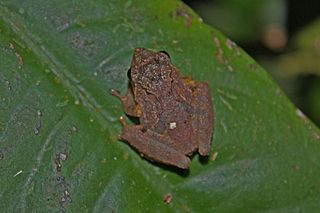
Rhinatrematidae is a family of caecilians, also known as the Neotropical tailed caecilians, American tailed caecilians. or beaked caecilians. They are found in the equatorial countries of South America.
Caecilia orientalis is a species of caecilian in the family Caeciliidae. It is found in Colombia and Ecuador. Its natural habitats are subtropical or tropical moist lowland forests, subtropical or tropical moist montane forests, rivers, freshwater marshes, intermittent freshwater marshes, pastureland, rural gardens, and heavily degraded former forest.
Caecilia pressula is a species of caecilian in the family Caeciliidae. It is found in Guyana and possibly Brazil. Its natural habitats are subtropical or tropical moist lowland forests.

Gymnopis multiplicata is a species of caecilian in the family Dermophiidae found in Costa Rica, Honduras, Nicaragua, Panama, and possibly Guatemala. Its natural habitats are subtropical or tropical dry forests, subtropical or tropical moist lowland forests, subtropical or tropical moist montane forests, pastureland, plantations, rural gardens, and urban areas.
Gymnopis syntrema is a species of caecilian in the family Dermophiidae. It is found in Belize, Guatemala, and possibly Honduras. Its natural habitats are subtropical or tropical moist lowland forests, subtropical or tropical moist montane forests, plantations, rural gardens, and heavily degraded former forest. It is threatened by habitat loss.
Ichthyophis asplenius is a species of amphibian in the family Ichthyophiidae found in Malaysia and possibly Thailand. It is also known as broad-striped caecilian, Boven Mahakkam caecilian and Malayan caecilian. It is only known with certainty from Mahakam River and Matang Hunting Reserve Its natural habitats are subtropical or tropical moist lowland forests, rivers, intermittent rivers, plantations, rural gardens, heavily degraded former forest, irrigated land, and seasonally flooded agricultural land.
Ichthyophis weberi, the Malatgan River caecilian, is a species of amphibian in the family Ichthyophiidae endemic to the Philippines. Its natural habitats are subtropical or tropical moist lowland forests, subtropical or tropical moist montane forests, rivers, intermittent rivers, plantations, rural gardens, heavily degraded former forests, irrigated land, and seasonally flooded agricultural land.
The pointed-headed caecilian, Ichthyophis acuminatus, is a species of amphibian in the family Ichthyophiidae endemic to Thailand. Its natural habitats are subtropical or tropical moist lowland forests, subtropical or tropical moist montane forests, rivers, intermittent rivers, plantations, rural gardens, heavily degraded former forest, irrigated land, and seasonally flooded agricultural land.
Ichthyophis bernisi, the Indonesian caecilian, is a species of amphibian in the family Ichthyophiidae endemic to Indonesia. Its natural habitats are subtropical or tropical moist lowland forests, subtropical or tropical moist montane forests, rivers, intermittent rivers, plantations, rural gardens, heavily degraded former forest, irrigated land, and seasonally flooded agricultural land.
Ichthyophis glandulosus, the Basilan Island caecilian, is a species of amphibian in the family Ichthyophiidae endemic to the Philippines. Its natural habitats are subtropical or tropical moist lowland forests, subtropical or tropical moist montane forests, rivers, intermittent rivers, freshwater springs, plantations, rural gardens, heavily degraded former forest, irrigated land and seasonally flooded agricultural land. The population is unknown as only two specimens have been collected.
The Javan caecilian is a species of amphibian in the family Ichthyophiidae endemic to Indonesia. Its natural habitats are subtropical or tropical moist lowland forests, subtropical or tropical moist montane forests, rivers, intermittent rivers, plantations, rural gardens, heavily degraded former forests, irrigated land, and seasonally flooded agricultural land.

The Koh Tao Island caecilian, Ichthyophis kohtaoensis, is a species of amphibian in the family Ichthyophiidae found in Cambodia, Laos, Myanmar, Thailand, and Vietnam. Its natural habitats are subtropical or tropical moist lowland forests, subtropical or tropical moist montane forests, rivers, intermittent rivers, swamps, freshwater marshes, intermittent freshwater marshes, plantations, rural gardens, urban areas, heavily degraded former forests, irrigated land, and seasonally flooded agricultural land.

Ichthyophis paucisulcus, the Siantar caecilian, is a species of amphibian in the family Ichthyophiidae found in Indonesia and Singapore. Its natural habitats are subtropical or tropical moist lowland forests, subtropical or tropical swamps, rivers, intermittent rivers, plantations, rural gardens, heavily degraded former forests, seasonally flooded agricultural land, and canals and ditches.

Philautus petersi is a species of frog in the family Rhacophoridae. It is found in Indonesia, Malaysia, Thailand, and possibly Brunei. Its natural habitats are subtropical or tropical moist lowland forests and subtropical or tropical moist montane forests. It is threatened by habitat loss.

The two-coloured caecilian, Epicrionops bicolor, is a species of caecilian in the family Rhinatrematidae found in Colombia, Ecuador, and Peru. Its natural habitats are subtropical or tropical moist montane forests, rivers, and intermittent rivers.
Epicrionops lativittatus, the eastern Peru caecilian, is a species of caecilian in the family Rhinatrematidae endemic to Peru. Its natural habitats are subtropical or tropical moist lowland forests, subtropical or tropical moist montane forests, and rivers.
Epicrionops marmoratus, the marbled caecilian, is a species of caecilian in the family Rhinatrematidae. It is endemic to Ecuador and only known from its type locality, Santo Domingo de los Colorados, and from near Mindo in the Pichincha Province in north-western Ecuador. It is a poorly known species that might be a junior synonym of Epicrionops bicolor.
Rhinatrema nigrum, the black caecilian, is a species of caecilian in the family Rhinatrematidae found in Guyana, Venezuela, and possibly Brazil. Its natural habitats are subtropical or tropical moist lowland forests, subtropical or tropical moist montane forests, rivers, and intermittent rivers.
Epicrionops parkeri, or Parker's caecilian, is a species of caecilian in the family Rhinatrematidae endemic to Colombia. Its natural habitats are subtropical or tropical moist montane forests, rivers, and intermittent rivers.
Epicrionops peruvianus, the Marcapata Valley caecilian, is a species of caecilian in the family Rhinatrematidae endemic to Peru. Its natural habitats are subtropical or tropical moist montane forests, rivers, and intermittent rivers.







